Related Research Articles

Macalester College is a private liberal arts college in Saint Paul, Minnesota. Founded in 1874, Macalester is exclusively an undergraduate four-year institution and enrolled 2,174 students in the fall of 2018 from 50 U.S. states, four U.S territories, the District of Columbia and 97 countries. The college has Scottish roots and emphasizes internationalism and multiculturalism.
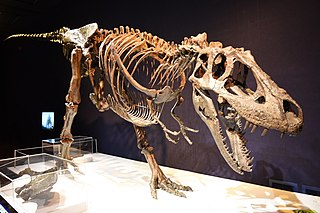
Daspletosaurus is a genus of tyrannosaurid dinosaur that lived in Laramidia between about 79.5 and 74 million years ago, during the Late Cretaceous Period. The genus Daspletosaurus contains three species. Fossils of the earlier type species, D. torosus, have been found in Alberta, and fossils of a later second species, D. wilsoni, and third species, D. horneri, have been found only in Montana. A possible fourth species, also from Alberta, awaits formal identification. The taxon Thanatotheristes has been suggested to represent a species of Daspletosaurus, D. degrootorum, but this has not been widely supported. Daspletosaurus is closely related to the much larger and more recent tyrannosaurid Tyrannosaurus rex. Like most tyrannosaurids, Daspletosaurus was a multi-tonne bipedal predator equipped with dozens of large, sharp teeth. Daspletosaurus had the small forelimbs typical of tyrannosaurids, although they were proportionately longer than in other genera.

Raymond Arthur Dart was an Australian anatomist and anthropologist, best known for his involvement in the 1924 discovery of the first fossil ever found of Australopithecus africanus, an extinct hominin closely related to humans, at Taung in the North of South Africa in the province Northwest.

Sauroposeidon is a genus of sauropod dinosaur known from several incomplete specimens including a bone bed and fossilized trackways that have been found in the U.S. states of Oklahoma, Wyoming, and Texas.

Amurosaurus is a genus of lambeosaurine hadrosaurid dinosaur found in the latest Cretaceous period of eastern Asia. Fossil bones of adults are rare, but an adult would most likely have been at least 6 metres (20 ft) long. According to Gregory S. Paul, it was about 8 metres (26 ft) long and weighed about 3,000 kilograms (6,600 lb).
John Raymond Zaller is a political scientist and professor specializing in public opinion at the University of California, Los Angeles. He was an Editor of the American Political Science Review. He graduated from Saint Monica Catholic High School in Santa Monica, CA. He pursued his undergraduate studies at the University of California, Riverside. He received his Ph.D. from the University of California, Berkeley in 1984.

Kristina "Kristi" Curry Rogers is an American vertebrate paleontologist and a professor in Biology and Geology at Macalester College. Her research focuses on questions of dinosaur paleobiology, bone histology, growth, and evolution, especially in a subgroup of sauropods called Titanosauria. She has named two dinosaur species from Madagascar, Rapetosaurus, the most complete Cretaceous sauropod and titanosaur found to date, and Vahiny, so far known only from a partial skull. She and Jeffrey A. Wilson co-authored The Sauropods, Evolution and Paleobiology, published in December 2005. Her research includes field work in Argentina, Madagascar, Montana, South Africa, and Zimbabwe.

Paleobiology is an interdisciplinary field that combines the methods and findings found in both the earth sciences and the life sciences. Paleobiology is not to be confused with geobiology, which focuses more on the interactions between the biosphere and the physical Earth.

Andrew Herbert Knoll is the Fisher Research Professor of Natural History and a Research Professor of Earth and Planetary Sciences at Harvard University. Born in West Reading, Pennsylvania in 1951, Andrew Knoll graduated from Lehigh University with a Bachelor of Arts in 1973 and received his Ph.D. from Harvard University in 1977 for a dissertation entitled "Studies in Archean and Early Proterozoic Paleontology." Knoll taught at Oberlin College for five years before returning to Harvard as a professor in 1982. At Harvard, he serves in the departments of Organismic and Evolutionary Biology and Earth and Planetary Sciences.
The Kaiparowits Formation is a sedimentary rock formation found in the Kaiparowits Plateau in Grand Staircase–Escalante National Monument, in the southern part of Utah in the western United States. It is over 2800 feet thick, and is Campanian in age. This Upper Cretaceous formation was formed from alluvial floodplains of large rivers in coastal southern Laramidia; sandstone beds are the deposit of rivers, and mudstone beds represent floodplain deposits. It is fossiliferous, with most specimens from the lower half of the formation, but exploration is only comparatively recent, with most work being done since 1982. It has been estimated that less than 10% of the Kaiparowits formation has been explored for fossils. Most fieldwork has been conducted by The Natural History Museum of Utah.
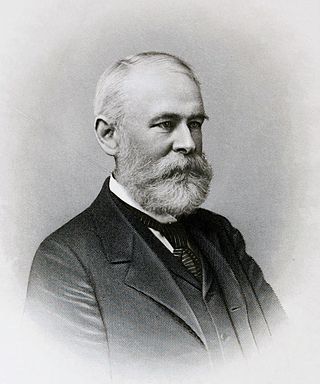
George Lansing Raymond, was a prominent professor of Aesthetic Criticism at Princeton University from 1881 to 1905, and author of a new system of esthetics. He was nominated for the Nobel Prize in Literature seven times.

Edmontosaurus regalis is a species of comb-crested hadrosaurid (duck-billed) dinosaur. Fossils of E. regalis have been found in rocks of western North America that date from the late Campanian stage of the Cretaceous Period 73 million years ago, but it may have possibly lived till the early Maastrichtian.

Philip Conrad James Donoghue FRS is a British palaeontologist and Professor of Palaeobiology at the University of Bristol.
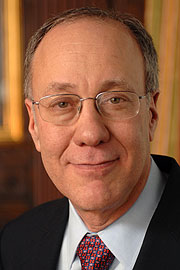
Roger Bruce Myerson is an American economist and professor at the University of Chicago. He holds the title of the David L. Pearson Distinguished Service Professor of Global Conflict Studies at The Pearson Institute for the Study and Resolution of Global Conflicts in the Harris School of Public Policy, the Griffin Department of Economics, and the college. Previously, he held the title The Glen A. Lloyd Distinguished Service Professor of Economics. In 2007, he was the winner of the Sveriges Riksbank Prize in Economic Sciences in Memory of Alfred Nobel with Leonid Hurwicz and Eric Maskin for "having laid the foundations of mechanism design theory." He was elected a Member of the American Philosophical Society in 2019.
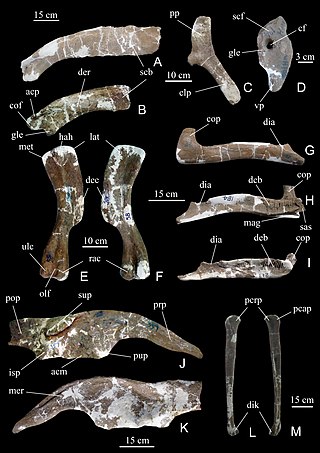
Wulagasaurus is a genus of saurolophine hadrosaurid dinosaur from the Late Cretaceous of Heilongjiang, China. Its remains were found in a bonebed in the middle Maastrichtian-age Yuliangze Formation, dated to 69 million years ago. This bonebed is otherwise dominated by fossils of the lambeosaurine hadrosaurid Sahaliyania. Wulagasaurus was named by Pascal Godefroit and colleagues in 2008. Only partial remains are known at this time. It is one of several hadrosaurids from the Amur River region named since 2000. The type and only species to date is W. dongi, named in honor of Chinese paleontologist Dong Zhiming. In 2010 Gregory S. Paul estimated its size at 9 meters and 3 tonnes.
Anthony Ricardo Fiorillo is a senior fellow at the Institute for the Study of Earth and Man at Southern Methodist University, but for many years he was vice president of research & collections and chief curator at the Perot Museum of Nature & Science. A native of Connecticut, he received his bachelor's at the University of Connecticut, his master's at the University of Nebraska and a Ph.D. in Vertebrate Paleontology from the University of Pennsylvania.

William R. Newman is Distinguished Professor and Ruth N. Halls Professor in the Department of History and Philosophy of Science at Indiana University. Most of Newman’s work in the History of Science has been devoted to alchemy and "chymistry," the art-nature debate, and matter theories, particularly atomism. Newman is also General Editor of the Chymistry of Isaac Newton, an online resource combining born-digital editions of Newton’s alchemical writings with multimedia replications of Newton’s alchemical experiments. In addition, he was Director of the Catapult Center for Digital Humanities and Computational Analysis of Texts at Indiana University. Newman is on the editorial boards of Archimedes, Early Science and Medicine, and HOPOS.
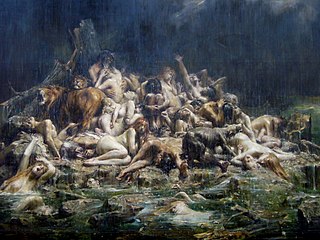
The Genesis flood narrative is the Hebrew version of the universal flood myth. It tells of God's decision to return the universe to its pre-creation state of watery chaos and remake it through the microcosm of Noah's ark.

Maria Gertrudis "Mieke" Bal is a Dutch cultural theorist, video artist, and Professor Emerita in Literary Theory at the University of Amsterdam. Previously she also was Academy Professor of the Royal Netherlands Academy of Arts and Sciences and co-founder of the Amsterdam School for Cultural Analysis at the University of Amsterdam.

Walter Julius Veith is a South African zoologist and a Seventh-day Adventist author and speaker known for his work in nutrition, creationism and Biblical exegesis.
References
- Notes
- ↑ "Raymond R. Rogers". Press.uchicago.edu. 12 December 2012. Retrieved 6 November 2014.
- ↑ "Archived copy" (PDF). Archived from the original (PDF) on 2012-09-27. Retrieved 2011-04-07.
{{cite web}}: CS1 maint: archived copy as title (link) - ↑ "Professor Rogers webpage". Macalester.ed. Archived from the original on 2014-11-24. Retrieved 6 November 2014.
- Sources
- Bonebeds: Genesis, Analysis, and Paleobiological Significance, Raymond R. Rogers, David A. Eberth and Anthony R. Fiorillo, University of Chicago Press, 2008, ISBN 978-0-226-72371-6